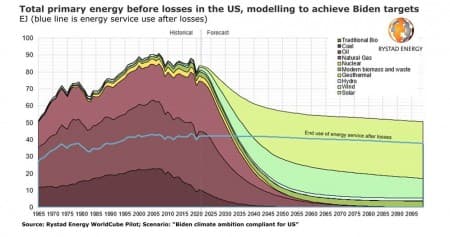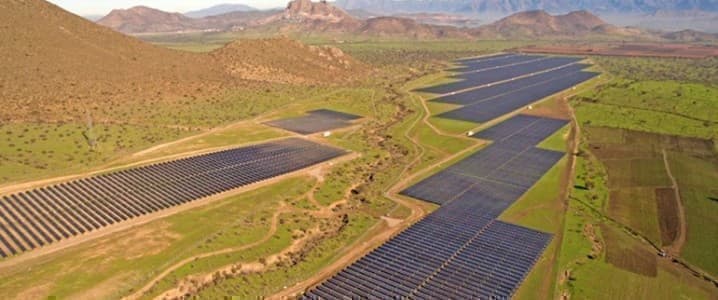The climate targets that were recently set by the Biden administration in the US represent a challenging task and require major changes in the country’s energy system that would shake the current fuel mix status quo. Rystad Energy has modelled what it considers the most achievable recipe to meet the tough targets set, a formula that includes generous reductions in fossil fuel use and spending $2.5 trillion in renewable energy projects this decade, a transition that will be facilitated by a coming reduction in battery costs. Although there are infinite ways to solve the equation, Rystad Energy’s model has produced a balance of what we consider the most viable energy mix. The results that the model suggests are of course not set in stone, and there can be deviations in a possible successful implementation of the plan, with certain variables adjusted in either direction to deliver on a ‘Biden compliant’ mix.
To reduce GHG emissions in the US by 50% by 2030, and do the legwork needed to continue on a climate-friendly path and meet further targets that are set for 2035 and 2050, our research team has devised a roadmap that is both balanced and conceivable. Here are the key elements of that roadmap:
- Reduction of US coal consumption by 65% by 2030 versus expected 2021 levels of about 500 million short tons
- Reduction of US oil consumption by 32% by 2030 vs estimated 2021 levels of 19 million bpd
- Reduction of US natural gas consumption by 27% by 2030 vs 2021 levels of 30 trillion cubic feet
- Share of battery electric cars in US’ new car sales needs to reach 24% in 2024 and 74% in 2028
- Share of non-fossil new truck sales in the US needs to reach 10% in 2024 and 49% in 2028
- Solar PV power output needs to grow from an estimated 100 TWh in 2021 to 2200 TWh in 2030
- Wind power output needs to grow from an estimated 400 TWh in 2021 to 2500 TWh in 2030
- Some 1500 GW of solar capacity and 700 GW of wind capacity needs to be added by 2030
- About 1800 GWh of batteries or flexible sources is needed to back-up solar and wind by 2030
- Some $2.5 trillion is needed for renewable investments from 2021 through 2030
- About 200 million tonnes of CCS capacity needs to be in operation in the US by 2030

“The targets set by the Biden Administration are very ambitious and any suggested plan, including ours, represents an extremely challenging journey. In any scenario, renewable energy will be the protagonist and flexible power will be needed to handle the intermittency as a result. If battery costs decrease fast enough, storage will be preferred against grid upgrades and the battery market could consequently flourish and become as big as the EV market,” says Jarand Rystad, chief executive officer at Rystad Energy.
Related: U.S. Oil Rig Count Soars As WTI Recovers
A result of Rystad Energy’s suggested energy mix above will be a carbon dioxide emission reduction from 6 Gt in 2005 to 3 Gt in 2030. Looking at all greenhouse gas emissions in the US, they will be reduced from 9 Gt in 2005 to 4.5 Gt in 2030. This decade’s hard work would set up a good base to then decarbonize the US power sector by 2035 and achieve the net-zero carbon emission goal in 2050.
What makes a ‘Biden compliant’ energy mix achievable:
The cost of solar PV is already cheaper than conventional power generation, with installed costs at approximately $1 billion per GW in 2021. This is expected to decline to $600 million per GW in 2030, or $1.2 billion per GW in 2030 including battery storage. There is a good business case to co-install batteries alongside solar plants, as the achieved price from hybrid projects would increase several times given that afternoon prices are on average two to four times higher than mid-day rates.
With batteries, equipment costs can also be reduced through scaling deliveries to a lower peak level. Solar PV resources are abundant along the coast and southern belt and, as such, additions of 25 GW per year in 2021 are expected to grow 10-fold to 250 GW in the early-2030s, as no other sources will offer better economics.
The US has a plethora of wind resources available as well. Onshore wind resources are bountiful in the mid-continent and Great Lakes regions, as well as in Texas, while offshore wind is prominent off the northeastern coast in the Atlantic and off the Pacific coast. To achieve these targets, both types of wind development must grow to a peak annual installation of 90 GW in 2026 and 2027.
Under normal weather conditions, wind and solar will generate 63% of the power in the US by 2030, and flexible power will be needed to handle the intermittency. Flexible sources, such as hydropower, will deliver 5% of the generation. Similarly, natural gas will deliver 16% of generation, while biomass, despite its declines, will deliver 1% generation in 2030. Nuclear and coal are not flexible and are inconvenient to be considered as back-up for renewables.
The cost of batteries will determine the balance point between choosing other flexible sources or grid upgrades. If battery costs decrease fast enough, it will create its own market both as integrated battery farms within solar and wind farms, and independently at various places in the main grids and within microgrids.
By Rystad Energy
More Top Reads From Oilprice.com:
- 3 Strong Oil And Gas Stocks For The Summer
- The ESG Bubble Has Finally Burst
- Iran To Saudi Arabia: Sell Our Oil And We Will Reduce Houthi Attacks



















Water moderated reactors are not best approach because of less usable temperature range melting 0°C boiling 100°C with pressure up to critical point 374°C also causing high overpressure risk and is spreading in accident case like graphite burning if used better Li-7 & ThO2 in Na reactor best if it can hold also.boiling bubbles or RBN Th pebble bed HTR !
Gas can and will be increased for about a decade as oil & coal im asis substitute then also going rare & expensive.
Electricity input price in world for atomic power is about 2.5 Cent-€/kWh lowest 2 Cent with BN 1200 but can be halfed to 1 Cent with new turbines and new zero risk reactors like RBN Th pebble bed using only unenriched natural ThO2 baked as granulate in RBN without QuadTrso cubic boron nitride isotopes B-11 & N-15 with about half neutron absorption of C-12 for 30.year pebble runtime unburnable & insoluble, diamond dense & hard and fission products left inside for end storage in stainless steel 30m.deep in desert etc. in compact HTR with tungsten reflector, 1.6m steel concrete W-double steel walls inside cooled.with Li-7 to turbines and back etc.
USA Inc. pays taxes as well...and pays out in benefits too which is income which of course can be taxed too *however* that would impede the climate goals. So sounds goofy dumb but "starts with submitting a Budget to Congress" simple as that.